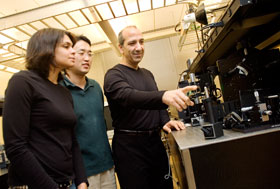  |
| HOME | THIS ISSUE | CALENDAR | GRANTS | BACK ISSUES | < BACK | NEXT > |
Engineer researching 3-D laser imaging to identify bacteriaby Michael Kirk - October 31, 2005 |
||||
|
Engineers at UConn are conducting research that could revolutionize the speed and method by which bacteria and micro-organisms can be automatically identified – work that has the potential to affect fields ranging from homeland security to medicine and biology. Currently, if public health officials want to test certain aspects of a water supply, for example, a sample must first be taken from the water, then brought to a lab and analyzed chemically before any findings can be determined. Similarly, if a physician needs to find out whether a patient’s blood or skin is contaminated with a certain kind of bacteria or other organism, a time-consuming process must be followed that can take hours, or even days. Bahram Javidi, Board of Trustees Distinguished Professor of electrical and computer engineering, is leading a team of researchers in developing a new three-dimensional optical-computer imaging and recognition process that would identify and analyze samples on-site in real time. He recently published a paper on the subject in the journal Optics Express, a leading publication in the field. “This is one of the most exciting projects we are working on,” says Javidi. His work to date has been funded with a $500,000 grant from the Defense Advanced Research Projects Agency, an arm of the U.S. Department of Defense. Javidi’s goal is to be able to load a sample from the air, blood, or water, for example, into a portable system on hand to detect and classify the types of bacteria that are contained in it. The system would use laser technology to produce a three-dimensional image of the organisms the sample contains. The image would then be analyzed by a specially programmed computer to determine its pattern and classify it. Bacteria and other organisms have distinct topography and signatures, says Javidi, that can best be identified through a sophisticated, three-dimensional image.
The system could also be used to produce an image of bacteria or other organisms in various media, such as air, water, clothing, and skin. Javidi says the process has potential applications for public health, customs, the military, and oceanography. “If this could be accomplished, you would have an on-site machine with laser imaging, interfaced with a laptop processor that could identify images of samples,” says Javidi. “This could classify the images, and red flag any known agents. The applications it holds to aid medicine, biology, and to combat biological warfare are clear. It could be of substantial help to human beings.” He says one of the challenges he faces is that bacteria change shape, and he is trying to develop ways to deal with that. Javidi gained preliminary results through a prototype device he has used to analyze safe biological substances, though he has been unable to analyze dangerous substances – such as the SARS bacteria – because of laboratory limitations and safety concerns. “The first steps are promising,” says Javidi. “We have at least demonstrated the feasibility, and our sponsors are very satisfied. Our role is on the research side. We have been able to let people know this is possible. We now need to collaborate with government labs, industry, schools of medicine and microbiologists to expand the scope of the research.” |
| ADVANCE HOME UCONN HOME |

